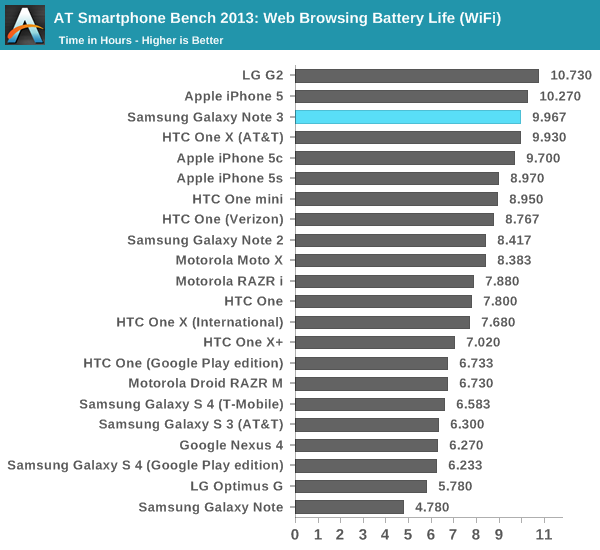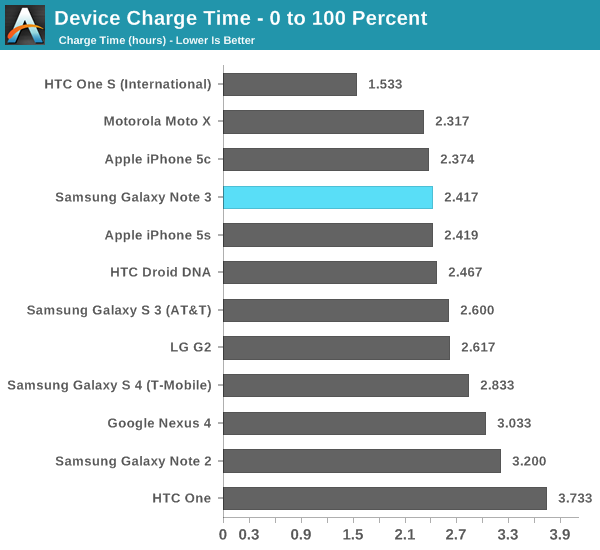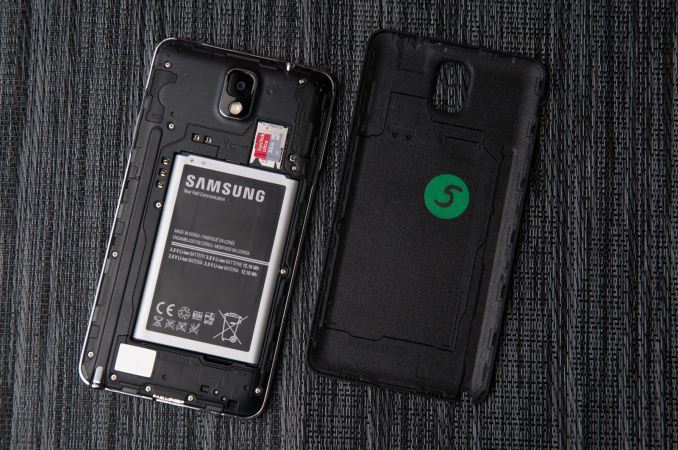Samsung Galaxy Note 3 Review
by Brian Klug on October 1, 2013 9:00 AM EST- Posted in
- Smartphones
- Samsung
- Mobile
- Android 4.3
- galaxy note 3
Battery Life
Battery life remains probably the single largest differentiator for devices lately, and of huge concern to enthusiasts and normal shoppers alike. We’ve already caught a glimpse of how well 8974 fares from a power perspective inside the LG G2, a device that posted some seriously impressive battery numbers. The Note 3 we’re looking at is also 8974 based since it’s a T-Mobile model, and thus we expect the same kind of battery life.
With this generation of Note, battery gets even larger. The Note started with a then quite large 9.25 watt hour battery, then Note 2 moved to 11.78 watt hours, and Note 3 now moves to a very large 12.16 watt hour battery with of course the newest 3.8V chemistry and all that comes along with it. Display size goes up, but those power gains are offset in other places.
After we talked about the panel self refresh features in the G2 a few people reached out and let me know that this feature has been shipping for a while in some phones, and it’s easy to check for. If we look under the display subsystem we can see that the same MIPI_CMD_PANEL type 9 is used, which refers to this type of interface.
Qualcomm HWC state: MDPVersion=500 DisplayPanel=9
define MIPI_CMD_PANEL ‘9’
Our battery life tests are unchanged and consist of a set of popular webpages that are loaded on a schedule with the display set to exactly 200 nits and repeated until the battery runs out and the device dies on both WiFi and cellular data connections. In this case that means T-Mobile LTE which is 10 MHz FDD in my market, I haven’t had a chance to run the Note 3 on HSPA+ yet, or complete the call test (which is starting to get ridiculous, and probably breaks 24 hours in the case of the Note 3).

On LTE the Note 3 does very well, coming just shy of the pack of iPhones, at just over 8 hours. Interestingly enough it’s just north of the G2s as well, which do have a smaller battery but also smaller display. The Note 3 also is the first device to ship with Qualcomm’s QFE1100 envelope tracker solution from the RF360 front end portfolio, which lowers power consumption by up to 20 percent and heat dissipation by up to 30 percent by allowing the power amplifiers to follow the desired output waveform. There’s more on that later in the cellular section.

On WiFi the Note 3 does better by 22 percent, but not the kind of huge jump I’m used to seeing between cellular and WiFi testing. This tells me the Note 3 battery life is really gated by the display, which is almost always the largest consumer of power in a device. That said the Note 3 does very well all things considered, especially in comparison to the APQ8064 (Fusion 3) phones which came before it, like SGS4. New silicon and new process inside MSM8974 definitely helps move battery life forward here with the race to sleep game.
Charging is an interesting story on the Note 3, but primarily because of what doesn’t change. The Note 3 continues to use Samsung’s tablet charging specification and charger, which has 2 amps of maximum output. The Note 3 draws 2 amps over a considerable amount of the charging curve, like other Samsung devices (in the linear part of the charge curve). USB 3.0 doesn’t change things up here quite yet with the new supported charge voltages that are coming eventually with the power delivery specification.

The Note 3 does charge faster overall compared to the SGS4 however thanks in part to the new PMIC (PM8941) which is part of the overall 8974 platform story.











302 Comments
View All Comments
Anand Lal Shimpi - Tuesday, October 1, 2013 - link
We definitely didn't minimize/brush aside blatant cheating. We were the first to report this story back in July: http://www.anandtech.com/show/7187/looking-at-cpug... The story is nothing new, it's the same thing (minus the GPU max clock manipulation).klagermkii - Tuesday, October 1, 2013 - link
That article makes it sound like it's a Samsung specific thing that was a problem, but now Brian makes it sound like it's across the whole smartphone industry. I never saw any article about that. Is it all of the manufacturers? Does iOS do it as well and does it impact 3DMark there when we're comparing offscreen rendering to Android? When we have benchmarks that include old and new devices, did the old devices not include the optimisations and thus the real world improvement you'd see with an upgrade isn't as big? When did this application targeting start?equals42 - Friday, October 11, 2013 - link
I think Chillin1248 was correct. If you know that the results are compromised do not publish them. I don't know that reviewers from other market segments would continue to quote results if they knew them to be wrong.Think of Consumer Reports reporting efficiency numbers on cars or dishwashers if they knew the results were skewed. They just wouldn't and they'd be beating the manufacturer over the head until the practice stopped. Major news outlets would catch on and cause a furor.
The apparent resignation to the practice that many of these sites promote is part of the problem.
vFunct - Tuesday, October 1, 2013 - link
Anandtech definitely lost a lot of credibility by even allowing these cheat results to be published.cupholder - Tuesday, October 1, 2013 - link
Apple fanboy detected.bji - Wednesday, October 2, 2013 - link
Moron alert.Talks - Saturday, October 12, 2013 - link
hmmm. want a real-world benchmark? see this, and comment afterwards:http://www.youtube.com/watch?v=jXX_35xy8Rc
then, enjoy your iPhone 5S......
PC Perv - Tuesday, October 1, 2013 - link
Think hard about what those "other OEMs" might be.Perhaps a certain fruit-named corporation this site gave ravishing reviews very recently?
Or how about the almighty that this site and some of its staffs admire/worship. I thought I'd heard something about the almighty cheating on Antutu or something.
Hard to keep a straight face when you are already in the deep. You reap what you sow.
vFunct - Tuesday, October 1, 2013 - link
So why keep using the benchmark if they're invalid by cheats?akdj - Wednesday, February 5, 2014 - link
Why would you spend A) Time to read the article, understand it and come to your own 'conclusions' ....and B) take the time to comment after the fact....an an article written, on a site 'taken over' by the mighty 'fruit-named corporation'?Man...another DBag alert. I take total exception to your wisdom, age and/or maturity. Find a site you trust. Read that one. Respond to that one. Go away. As an iPhone 5s and Note 3 owner, this review....as well as the 5s review echo my near six month experiences with both products. Just happened across your silky comment. Cheating is cheating. Anand was the first to find AND exploit/expose it. Initially it was during testing of a Samsung handset. Since August, he's now learned (and edited the review to reflect this) Snapdragon equipped sets from several OEMs are exploiting the same 'cheat'. IOW, this isn't inherent to Samsung. iOS he's also made extremely clear that he doesn't 'believe' it's being done...Apple denies any tinkering but he/they (Anand & Brian) aren't able to 'guarantee with confidence' if they are or not. iOS is locked down. As is the A7. Different system and sounds like it's an extremely secure chip and tough to reach the 'root' in order to absolutely confirm or deny with certainty. It's in all recent reviews. They've done more than any other....Ars took Anand's original post as a 'link back' article when discovered. Doesn't matter. Neither is the NY times, Chicago tribune or Brian Williams's nightly NBC newscast. It's a tech site. Of Sammy's billion customers and Apple's half billion....there's an extremely small percentage that will hear, know or but none the wiser of these benchmarks. That they've 'cheated'. Or that they even EXIST. The iPhone 5s and Note 3 are marvels in engineering. Their app and software selections these days are astounding. As a 42 year old avid fan if technology....and growing up with an Apple IIe as my first computer in the early 80s....I'm astounded by the power, speed, displays, battery life....connectivity and LTE speeds, media, mags and music and movies and photography manipulation, motion picture creation...cameras being used by Nat Geo on world shoots. A few ounces. In our pocket...faster than computers a half decade ago, more reliable and faster 'internet access', email download and sends, SMS and Skype/FaceTime. All genuine and powerful apps. GarageBand. The entire productivity suite....both OSx'ea iOS version and a half dozen options in the Play store with excellent editing and creation options for the MS office suite, Word, Excel and PowerPoint. And again, all that in your pocket
What amazes me more....dbags jumping in claiming someone else is an iOS (or Android) 'fanboy' because he or she disagrees with this scandal. That is SILLY! These speeds can't be replicated in a game or number crunching and extended CPU load times with the battery life anything but an hour, maybe 75 minutes. It's a sham. Should be stopped. Anand's done his job. You should A) apologize or B) leave. Don't comment. Find a hobby and site you enjoy and 'trust'
J